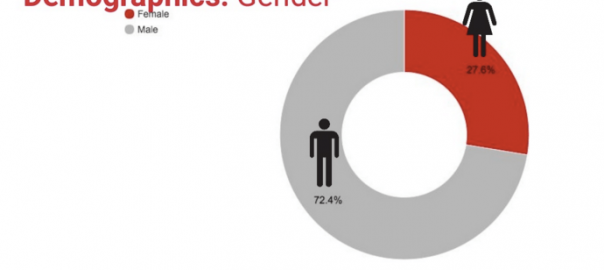
While there are encouraging signs of growth and maturity, the ConversionXL 2016 State of Conversion Optimization report shows there are still areas of opportunity to establish conversion rate optimization as a mainstream marketing practice.
In this year’s survey, we asked 722 respondents 48 questions about who they are, where they work, and how they optimize. We got the inside scoop on what optimizers make in salary, what their biggest challenges are, and what their testing programs are like.
I’ll summarize the findings and offer some advice based on our insights, but first, here are some key demographics to contextualize the results.
What Does an Optimizer Look Like in 2016?
First off, optimizers go by many names.
We had respondents report 75+ different self-proclaimed titles – the thing they have in common is that they’re all running tests and driving data-fueled growth.
A few of the most popular titles from our survey included:
- Analyst
- Conversion Optimizer
- Conversion Specialist/Consultant/Strategist
- Director of Marketing
- Project Manager
58% of these folks work in-house, meaning they work on their own employer’s site. 39% work for an agency or do freelancing.

In addition, most of those who work in-house do so for eCommerce sites (33.9% of total respondents). Very few of our respondents work in publishing/media or nonprofits/government, but 13.8% said they work for a SaaS company.

How large were the companies that made up our survey? While we had a range of answers, the most frequently reported annual revenue was under $ 100,000…

The average salary of an optimizer was $ 71,340, but average salaries differed from country to country.
Those in the US had the highest average salary ($ 87,926). For comparison, here are the four countries from which we had the most respondents and their corresponding average salaries (all converted to USD):

There was also a difference in salary based on company size. The average salary of optimizers in companies with less than 500 employees was $ 69,469/year, while those in larger companies (500+) averaged $ 78,120/year.
Finally, most of our respondents identified as male (72.4%) where only a quarter of our respondents identified as female (27.6%).

Key Findings in the 2016 Report
- Optimization is still a very new profession, with 50% of respondents having worked in the industry for 3 or fewer years (20% of optimizers have been working in the industry for less than one year.
- Who owns optimization at your company? Only 29% of people said that there’s a single person dedicated to optimization. 30% more said there’s a team in charge of optimization. But 41% of respondents had no one directly accountable for optimization efforts.
- Many companies still don’t have a repeatable optimization process in place. 26% of small companies (less than 500 employees) and 20% of large companies (more than 500) said they don’t have a process at all. Only 32% of small companies (and 42% of large companies) said they have a structured and documented process.
- Companies with a structured process are more likely to increase their conversion optimization budgets next year than those without a structured process. They’re also more likely to have plans to focus more on optimization and increase their optimization budget in 2016.

- Conversion optimization budgets are still underserved compared to other part of marketing, like content marketing. 53% of respondents said that there’s no documented budget for CRO in their companies. Reported budgets, however, ranged from $ 1,000 to $ 3 million.
- A majority of our respondents run less than 5 tests a month, many of them (43%) run only 1-2 a month. 5% of respondents said they were running 21+ tests a month.
- Only 48% of respondents said they’re tracking lift per successful experiment, and only 37% said they track their percentage of winning tests (also known as experiment win rate).
- 79% of respondents said they share CRO results across their team (although surprisingly 56% of teams don’t have standardized stopping rules for tests).

- 26% said their teams meet “only when necessary.” What if finance or operations met “only when necessary”? They probably wouldn’t be taken very seriously. We do a weekly growth meeting at CXL and talk about experiments we’re currently launching and those we’ve wrapped up. You can find a way to do it at your own company, but the importance is the routine.
- Digital analytics was rated as the most useful tool for optimizers (rated 4.2 out of 5), followed by A/B testing and UX design (both rated 4 out of 5).
- Optimizely carries a strong lead in popularity among our respondents.

- 64% of respondents didn’t use any personalization at all. Even with all the buzz about personalization, people are struggling with implementation (another study showed that ninety-four percent of customer insights and marketing professionals across multiple industries said personalization is “important,” “very important,” or “extremely important” for meeting their current marketing objectives),
- Where do people learn about conversion optimization? 75% of respondents learn about conversion optimization from blogs. This was an open ended question (where do you learn about conversion optimization), but blogs were overwhelmingly the most reported statement, followed by courses and conferences.
All that data is /r/mildlyinteresting, but what’s data without a clear path to action?
Top Challenges in Conversion Optimization
We asked an open-ended question to try to figure out what survey respondents’ biggest optimization challenges were. Though the answers were diverse, we could generally group them into three categorize that came up most often:
- Lack of time.
- Lack of CRO know-how.
- Lack of resources.
Many optimizers (again, open-ended so hard to quantify) struggled with discovering what to test as well as how to run tests properly. They consistently brought up 1) a lack of time to learn about optimization practices and 2) a lack of internal resources to invest in learning about optimization.
Luckily, there are great resources available at Optimizely’s academy as well as our own ConversionXL Institute.
Conclusion
Much of the uphill battle with the conversion optimization industry will be cementing it into a teachable and repeatable trade. A commenter on our original report said,
“If you ask 10 people what a CRO is/does, you are more than likely going to get 15 answers, as it’s something that is akin to what an SEO used to be. 15 years ago if you knew how to alter Google’s results in your favor, you were a black magic wizard that could demand whatever price, or hold whatever ransom you wanted.”
Conversion optimization is still a young industry, but growing rapidly. With that growth, we’ll even out the kinks and hopefully get some more data on what processes and strategies work well.
Read the original report over at ConversionXL.
Digital & Social Articles on Business 2 Community(58)




